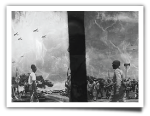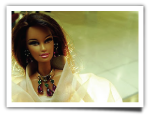Tuesday, June 14, 2011
Independence Day Fashion: The Barong Pambabae
Posted by
Musa
5:37 PM
Over the weekend, I was collaborating with a fellow Inquirer contributor on an Independence Day article on fashion that's Filipino. Unfortunately, our article didn't make it in time for the weekend run. But I'm glad I got to clarify my thoughts on the importance of taking inspiration from your own backyard. The reason I started blogging is because I believe that we take our own culture for granted by following styles and trends from other countries. We have to love our own. We have to create a distinctive Filipino aesthetic.
With that, I present the Barong Pambabae.
This is the first time I've ever donned a Barong Tagalog. I must say, I felt empowered. And chic. Maybe, it's because I'm wearing something traditionally made for men. Maybe, it's because this slim-fit barong belongs to the fashion forward Sib Sibulo.
Barongs are made of lightweight, translucent material. It dates back to Spanish colonial times and was derided as Indiowear. Some historians believed that the Spanish stipulated the barong as the outfit for native Filipinos because you can see through the fabric. It made it easier to spot concealed weapons. (Now it's good for hiding jabar.)
I'm happy it became all the rage again in the late 1950s when President Ramon Magsaysay made it his daily uniform. I'm definitely going to have my own Barong made someday. I'll get the expensive one made from Pineapple fiber. I think this one is made of Banana or Abaca which is reasonably priced and less prone to tearing. I imagine wearing it to a wedding while everyone else is a long gown. Snazzy. Outfit: Sib's groomsman Barong Tagalog; My grade school Doc Martens;
Pocket watch, antique cane, and woven hat from Chris Yambing.
Photo credits: First one by the foxy Mr. Chris Yambing.
The rest from the lovely Ms. Kaity Chua.
Styling credits: Deng Tee and Cay Kho
- Mona Chang June 14, 2011 at 7:04 PM
-
Nice one!
You know what, my foreign co-teachers just love our national costume. They even have one! And they are actually wearing it on during our formal functions.
Just love seeing those "White people" on this "kayumanggi" frock! - Anonymous June 15, 2011 at 7:52 PM
-
Ang photogenic ng Barong Tagalog. Saying, nag init niyang suotin! Ahahaah. Cheers Musa!
- Musa June 29, 2011 at 4:35 PM
-
Hi Kaity, I know right. Wink wink.
Hi Mona, agreed. It looks great on everyone.
Hi anonymous, cheers to you too! - Welcome to the Candie Shop July 13, 2011 at 10:11 AM
-
I LOVE IT!!!! SUPER!!!!!! ganda! you are so fashionable, as i always say!
6
comments:

Search This Blog
About Me
Halo-Halo Blog
This blog is like the Filipino dessert that mixes together unrelated ingredients such as ice, beans, gelatin, purple yam, and cream into something fun. Here’s a yummy serving of my own halo-halo musings on art, advertising, history, fashion, photography and inspiration.
Labels
- Events (38)
- Fashion (27)
- Advertising (18)
- History (10)
- People (10)
- Musa Liked Websites (8)
- Personal (6)
- Weekend (6)
- Illustration (5)
- Photography (5)
- Travel (5)
- Ambeth Ocampo (3)
- Filipino designers (3)
- Inspiration (2)
- Silverlens (2)
- Aetas (1)
- B Side (1)
- Barbie (1)
- Barriotic Mentality (1)
- Cannes (1)
- Folk Music (1)
- Gig (1)
- Ifugao (1)
- Imelda (1)
- Teodulo Protomartir (1)
- World War II (1)










Gwapo mo, Knox. :)